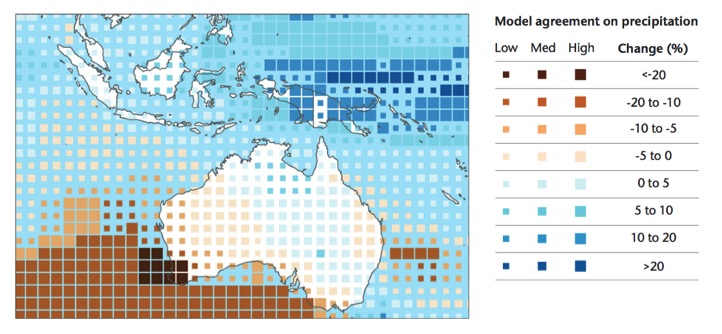by Satrio Adi Wicaksono

In a speech delivered to Indonesian students in Jakarta in 2014, United States Secretary of State John Kerry boldly stated that climate change is perhaps ‘the world’s most fearsome weapon of mass destruction’ and Indonesia is ‘one of the most vulnerable countries on Earth’ due to climate change. A close look at climate-related death statistics compiled by the Brussels-based Centre for Research on the Epidemiology of Disasters, which included deaths caused by droughts, floods, landslides, and storms, suggest Kerry was not exaggerating. Between 1980 and 2007, more than 174,000 Indonesians died in climate-related disasters. Apart from Ethiopia, the death toll was higher than any other country.
More droughts? More floods?
Climate change is going to have some major consequences in Indonesia through changing rainfall patterns, although the impacts will vary across regions. As an example, the latest Intergovernmental Panel on Climate Change (IPCC) report suggests that the Nusa Tenggara islands will become dryer while other islands will become wetter by the end of the century. Scientists have already observed deviations from the twentieth century average rainfall, as well as the average length of dry and rainy seasons, for many Indonesian islands. These trends, if they continue, are worrying. Significant increase in rainfall during the rainy season may lead to higher risk of flooding and landslides, whereas delayed rainfall and a longer dry season in the country’s rice-producing regions mean an extended paceklik (hungry season) for farmers, who can no longer predict when the rainy season will start. Fishermen are already finding it harder to predict monsoonal weather patterns, or what fish they can catch with which nets. More extreme weather events mean less time at sea. Both farmers and fishermen undoubtedly face declining livelihoods due to climate change.
Many Indonesian farmers and fishermen are already familiar with El Niño and La Niña – climate phenomena occurring at irregular intervals of two to seven years which bring extended drought (in the case of El Niño) or wetter than usual conditions (during La Niña). Scientists think stronger and more frequent El Niño/La Niña events are likely to take place under the emerging climate regime, exacerbating the negative impacts of both phenomena, such as paceklik during El Niño and floods during La Niña.
During an unusually strong 1997-1998 El Niño event, Indonesia experienced a major shortfall of rice production, forcing imports to a record 5.8 million tons in 1998, the largest quantity of rice ever imported by a single nation. The El Niño-induced drought also exacerbated forest fires in Kalimantan and Sumatra in 1997-1998, triggered primarily by illegal land clearing. Smoke and haze from the fires shrouded much of Sumatra, Singapore, the Malaysian Peninsula, and Kalimantan, at a total cost of some US$4.4 billion. Weather-related damage and losses will likely balloon if strong El Niño/La Niña events become the future norm.
During an unusually strong 1997-1998 El Niño event, Indonesia experienced a major shortfall of rice production, forcing imports to a record 5.8 million tons in 1998, the largest quantity of rice ever imported by a single nation. The El Niño-induced drought also exacerbated forest fires in Kalimantan and Sumatra in 1997-1998, triggered primarily by illegal land clearing. Smoke and haze from the fires shrouded much of Sumatra, Singapore, the Malaysian Peninsula, and Kalimantan, at a total cost of some US$4.4 billion. Weather-related damage and losses will likely balloon if strong El Niño/La Niña events become the future norm.
Climate model projections for Indonesia
Computer models have been widely used by the climate science community to simulate and project future climate conditions. There are approximately thirty major climate-modelling labs around the world with supercomputer facilities capable of handling the sophisticated calculations needed to run climate simulations. These models incorporate the physics and chemistry of land surfaces, atmosphere, and the oceans, though they each must also involve a large number of simplifying assumptions. Each model is somewhat unique, and different models are better at capturing different climate processes.
The IPCC has chosen some of the world’s most advanced climate models to run a set of coordinated experiments to provide an improved best-estimate forecast of future climates. These experiments allow us, for example, to compare how each model independently simulates precipitation under different scenarios of future fossil fuel use.
The simulation results for Indonesia are interesting. Though most models agree that the temperature will increase by two to four degrees Celsius by 2100, there is little agreement on the trend and magnitude of rainfall changes across different parts of Indonesia. This makes it difficult to project how El Niño/La Niña phenomena will behave and how wet or dry a particular region is going to be in the future. How to effectively model the complexity of Indonesian precipitation is a challenge that has yet to be resolved, and this has led some people within the climate science community to think they might be able to improve the work of climate models – especially in the Indonesian context – by adding a new dimension: looking into how climate has changed in the past.
The IPCC has chosen some of the world’s most advanced climate models to run a set of coordinated experiments to provide an improved best-estimate forecast of future climates. These experiments allow us, for example, to compare how each model independently simulates precipitation under different scenarios of future fossil fuel use.
The simulation results for Indonesia are interesting. Though most models agree that the temperature will increase by two to four degrees Celsius by 2100, there is little agreement on the trend and magnitude of rainfall changes across different parts of Indonesia. This makes it difficult to project how El Niño/La Niña phenomena will behave and how wet or dry a particular region is going to be in the future. How to effectively model the complexity of Indonesian precipitation is a challenge that has yet to be resolved, and this has led some people within the climate science community to think they might be able to improve the work of climate models – especially in the Indonesian context – by adding a new dimension: looking into how climate has changed in the past.
‘Don’t abandon history!’
Sukarno, the founding father of the Republic of Indonesia, once remarked famously, ‘Don’t ever abandon history!’ His message would bring nods of approval from palaeoclimatologists, a subset of climate scientists whose primary work is to reconstruct past climate conditions. They aim to better understand the dynamics of climate change by anchoring global and regional predictions to an understanding of past conditions and processes.
The work of palaeoclimatologists helps climate modellers to replicate past climate conditions and in so doing make future predictions more accurate. With the help of past climate data, the efficacy of current climate models can thus be improved. Long-term reconstructed rainfall data across different parts of Indonesia from different time periods can be used to test climate models and to reduce the disagreement about projected rainfall patterns for Indonesia.
Projected future climate changes in Indonesia will likely occur at faster rates and will be of a greater magnitude than in the past. Nevertheless, studying past episodes of climate change can provide us with insight on how complex rainfall systems operate in Indonesia and what we might expect from human-induced global warming. The Earth’s climate has changed many times in the past, mostly due to long-term cycles in the globe’s orbital position as it revolves around the sun, as well as variations in greenhouse gases and aerosols. The more recent climate change has been attributed to the rapid increase in the concentration of carbon dioxide – an important greenhouse gas – since the Industrial Revolution. Preliminary studies, including the work that I have been conducting in Sulawesi, and described later in the article, indicate that these past global changes induced significant precipitation changes in Indonesia.
Understanding Indonesian precipitation is also crucial because of the geophysical importance of its location. The waters surrounding Indonesia are the warmest in the world, which leads to strong atmospheric convection and high annual rainfall in most parts of Indonesia, especially compared to other regions on Earth. This in turn has given rise to the archipelago’s diverse tropical rainforest ecosystems. An interconnected global climate system means Indonesia’s warm waters also serve as a major source of global water vapour and heat transport, essentially energising the Earth’s water and energy cycles. A firmer understanding of Indonesian rainfall histories will thus give climate scientists a clearer picture of feedbacks associated with water and heat transport cycles, which may lead to better predictions of climate change in Indonesia and globally.
The work of palaeoclimatologists helps climate modellers to replicate past climate conditions and in so doing make future predictions more accurate. With the help of past climate data, the efficacy of current climate models can thus be improved. Long-term reconstructed rainfall data across different parts of Indonesia from different time periods can be used to test climate models and to reduce the disagreement about projected rainfall patterns for Indonesia.
Projected future climate changes in Indonesia will likely occur at faster rates and will be of a greater magnitude than in the past. Nevertheless, studying past episodes of climate change can provide us with insight on how complex rainfall systems operate in Indonesia and what we might expect from human-induced global warming. The Earth’s climate has changed many times in the past, mostly due to long-term cycles in the globe’s orbital position as it revolves around the sun, as well as variations in greenhouse gases and aerosols. The more recent climate change has been attributed to the rapid increase in the concentration of carbon dioxide – an important greenhouse gas – since the Industrial Revolution. Preliminary studies, including the work that I have been conducting in Sulawesi, and described later in the article, indicate that these past global changes induced significant precipitation changes in Indonesia.
Understanding Indonesian precipitation is also crucial because of the geophysical importance of its location. The waters surrounding Indonesia are the warmest in the world, which leads to strong atmospheric convection and high annual rainfall in most parts of Indonesia, especially compared to other regions on Earth. This in turn has given rise to the archipelago’s diverse tropical rainforest ecosystems. An interconnected global climate system means Indonesia’s warm waters also serve as a major source of global water vapour and heat transport, essentially energising the Earth’s water and energy cycles. A firmer understanding of Indonesian rainfall histories will thus give climate scientists a clearer picture of feedbacks associated with water and heat transport cycles, which may lead to better predictions of climate change in Indonesia and globally.
How do palaeoclimatologists reconstruct Indonesian rainfall history?
The recording of weather and climate in Indonesia was begun by the Dutch around mid-nineteenth century. With only 150 years of climate records, however, it is difficult to understand longer-term trends and dynamics of climate variability in the archipelago. To reconstruct past climate conditions beyond what is recorded by these direct records, palaeoclimatologists look to proxy measures of rainfall preserved within tree rings, corals, polar ice cores, cave stalagmites, and sediments from lakes and oceans. These data can then be calibrated to modern-day temperature and rainfall, which will allow scientists to estimate past climate conditions.
At present, the reconstruction of Indonesian rainfall history is a bit like trying to fit together a jigsaw with some pieces missing. There are a limited number of long-term, high-resolution precipitation records from the region. These records tend to be patchy, in terms of spatial and temporal coverage. The Indonesian archipelago’s vast area, combined with the topography of its islands, also means that the precipitation history of Sulawesi will be different, for example, from that of Papua.
At present, the reconstruction of Indonesian rainfall history is a bit like trying to fit together a jigsaw with some pieces missing. There are a limited number of long-term, high-resolution precipitation records from the region. These records tend to be patchy, in terms of spatial and temporal coverage. The Indonesian archipelago’s vast area, combined with the topography of its islands, also means that the precipitation history of Sulawesi will be different, for example, from that of Papua.
Despite this complexity, the climate records available for Indonesia have turned out to be very useful for understanding the sensitivity of this region to climate change. For example, a research project of mine indicates that the climates of central Sulawesi have varied considerably in the last 50,000 years. Analyses of the carbon isotopes of leaf wax (a marker for climate-dependent plant biomass such as closed-canopy rainforests and savannas), extracted from a thirteen-metre sediment core of Lake Towuti in East Luwu Regency, South Sulawesi, have suggested that the normally wet, tropical climate was interrupted by a severe dry period during the peak of the last ice age, from around 33,000 to 16,000 years ago. At that time, much of lowland central Sulawesi, currently filled by lush tropical rainforests, was covered by widespread grasslands similar to those found in eastern Nusa Tenggara. There is a strong indication that glaciers covering vast swathes of the northern hemisphere at this time can easily shift the path of the Indonesian monsoon, causing dry conditions in central Indonesia and wetter climate in northern Australia.
However, a similar dataset from the nearby Lake Matano, located at a higher altitude, suggests that that the high mountains near Lake Matano remained home to rainforests even during the dry ice age, indicating the persistence of wetter condition in some parts of Sulawesi. The contrasting findings between Lake Towuti and Lake Matano is important as it illustrates the role of high elevation regions as a refuge for tropical rainforests during historic drying periods and in the establishment of the current high biodiversity in the region.
Many palaeoclimatologists I know were drawn into the field not only due to the field’s scientific importance in advancing our prediction of future climate, but also because of palaeoclimatology’s multifaceted nature. It is a fascinating, multidisciplinary field, combining geology, archaeology, history, chemistry, physics, biology, and ocean sciences. The work I have been doing in Sulawesi and other Indonesian islands since I started my doctoral program has made me realise that palaeoclimatology is not only highly rewarding scientifically, the field and laboratory work that go into producing the climate data are also equally enjoyable.
However, a similar dataset from the nearby Lake Matano, located at a higher altitude, suggests that that the high mountains near Lake Matano remained home to rainforests even during the dry ice age, indicating the persistence of wetter condition in some parts of Sulawesi. The contrasting findings between Lake Towuti and Lake Matano is important as it illustrates the role of high elevation regions as a refuge for tropical rainforests during historic drying periods and in the establishment of the current high biodiversity in the region.
Many palaeoclimatologists I know were drawn into the field not only due to the field’s scientific importance in advancing our prediction of future climate, but also because of palaeoclimatology’s multifaceted nature. It is a fascinating, multidisciplinary field, combining geology, archaeology, history, chemistry, physics, biology, and ocean sciences. The work I have been doing in Sulawesi and other Indonesian islands since I started my doctoral program has made me realise that palaeoclimatology is not only highly rewarding scientifically, the field and laboratory work that go into producing the climate data are also equally enjoyable.
The more, the merrier
Completing the jigsaw puzzle of Indonesian climate history is no easy task. Proxy records of precipitation preserved underneath Indonesian seas and lands are highly useful for understanding future climate change, but they are often difficult and expensive to uncover and analyse. For example, the budget for the coring project in central Sulawesi, excluding laboratory analyses, was approximately US$100,000.
Another problem is there are only a handful of palaeoclimatologists working to understand long-term changes in Indonesian climate, and very few of them are Indonesians. To my knowledge, less than ten professors and researchers are working full time in this field at Indonesian institutions, and there are only six postgraduates completing theses in this field in foreign universities. Although there has been an uptake in palaeoclimate research in Indonesia over the last few years, many interesting research questions remain to be answered, especially regarding the state of rainfall during climate change intervals deeper in time (Geologists and paleoclimatologists often refer to the periods occurring before 10 thousand years ago as "deep time" periods, at least in the geology timescale).
Building on the success of our work on Sulawesi’s past precipitation during the last ice age, the research group I am working with is now spearheading an effort to recover even deeper sediment records from Lake Towuti, all the way down to the lake’s bedrock (up to 170 metres of sediment). In what will be the first scientific lake drilling project in Southeast Asia, 39 scientists from 17 institutions across six countries work collaboratively to understand the response and sensitivity of Sulawesi precipitation and rainforests to global climate changes over the past 800,000 years. Indonesia is huge, so work like this in other regions will be essential to completing the puzzle of Indonesian climate history. We need to know a lot more before we can understand Indonesia’s vulnerability to climate change and improve our ability to predict future precipitation patterns.
Satrio Adi Wicaksono (satrioadi.wicaksono@gmail.com) is a PhD candidate in climate science at Brown University in Providence, USA. He serves as Project Coordinator for the scientific drilling project of Lake Towuti in central Sulawesi, due to commence in May 2015 (http://facebook.com/
Another problem is there are only a handful of palaeoclimatologists working to understand long-term changes in Indonesian climate, and very few of them are Indonesians. To my knowledge, less than ten professors and researchers are working full time in this field at Indonesian institutions, and there are only six postgraduates completing theses in this field in foreign universities. Although there has been an uptake in palaeoclimate research in Indonesia over the last few years, many interesting research questions remain to be answered, especially regarding the state of rainfall during climate change intervals deeper in time (Geologists and paleoclimatologists often refer to the periods occurring before 10 thousand years ago as "deep time" periods, at least in the geology timescale).
Building on the success of our work on Sulawesi’s past precipitation during the last ice age, the research group I am working with is now spearheading an effort to recover even deeper sediment records from Lake Towuti, all the way down to the lake’s bedrock (up to 170 metres of sediment). In what will be the first scientific lake drilling project in Southeast Asia, 39 scientists from 17 institutions across six countries work collaboratively to understand the response and sensitivity of Sulawesi precipitation and rainforests to global climate changes over the past 800,000 years. Indonesia is huge, so work like this in other regions will be essential to completing the puzzle of Indonesian climate history. We need to know a lot more before we can understand Indonesia’s vulnerability to climate change and improve our ability to predict future precipitation patterns.
Satrio Adi Wicaksono (satrioadi.wicaksono@gmail.com) is a PhD candidate in climate science at Brown University in Providence, USA. He serves as Project Coordinator for the scientific drilling project of Lake Towuti in central Sulawesi, due to commence in May 2015 (http://facebook.com/





